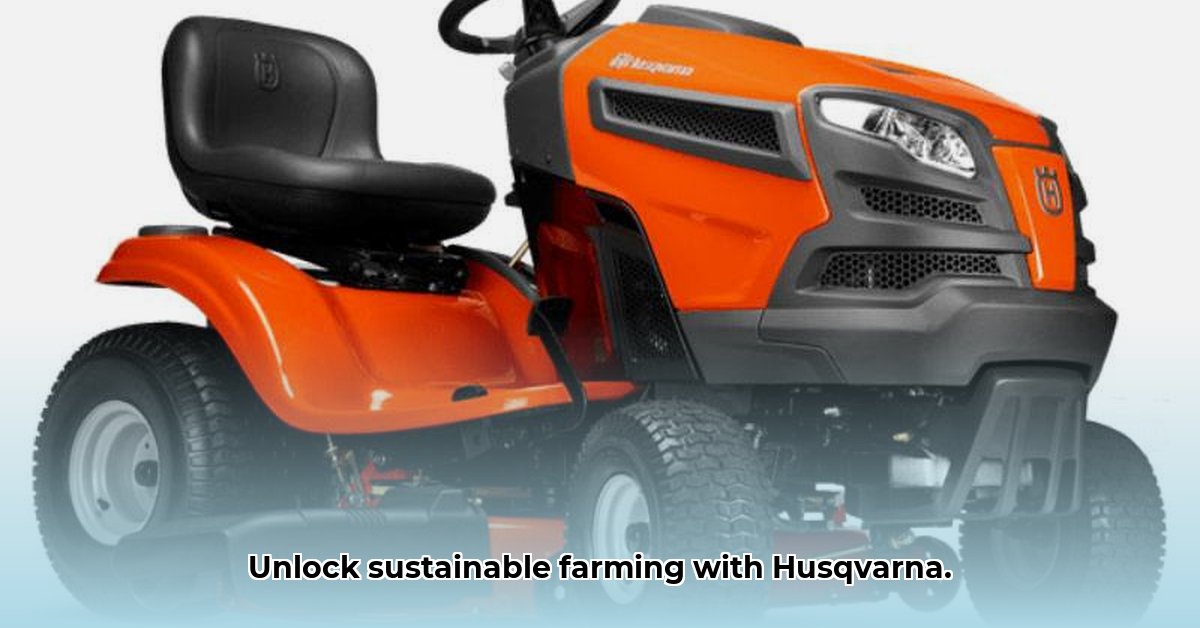
Husqvarna Yard Tractor Attachments: Your Path to Sustainable Farming
Sustainable farming isn't just a buzzword; it's a necessity. Husqvarna yard tractor attachments offer a powerful way to boost productivity while minimizing your environmental footprint, whether you're tending a small backyard garden or a larger operation. This guide will help you select the right attachments, use them efficiently, and contribute to a greener future for your farm. For even more powerful clearing capabilities, check out this brush hog attachment.
Picking the Perfect Attachments: Matching Tools to Your Needs
Selecting the right Husqvarna attachments is crucial for efficiency and minimizing unnecessary work. Consider your primary tasks: soil preparation, mowing, material handling, or aeration? The size of your land and soil type also significantly influence your choices. A small herb garden requires different tools than a large field of corn, and heavy clay soil needs a different approach than sandy loam.
Here's a comparison of popular Husqvarna attachments and their ideal applications:
| Attachment Type | Best Uses | Sustainability Considerations |
|---|---|---|
| Tiller | Preparing seedbeds, loosening compact soil | Use sparingly; explore no-till methods where possible |
| Mower (various types) | Lawn care, weed control, various cutting heights | Choose the right cut height; minimize passes for fuel savings |
| Material Handling Bucket | Moving materials, spreading compost/manure | Opt for durable construction; reduces manual labor |
| Aerator | Improving soil drainage, better aeration | Reduces soil compaction, promotes healthier soil |
| Snowblower (seasonal) | Removing snow | Reduces reliance on less efficient methods |
"Choosing the right attachment is like selecting the right tool for a specific carpentry job. Using the wrong tool leads to inefficiency and may even damage materials," says Dr. Emily Carter, Agricultural Engineer at Cornell University.
Building a Sustainable System: Durability, Repairs, and the Big Picture
Durability is paramount for sustainable farming. Investing in high-quality, long-lasting Husqvarna attachments reduces waste and the environmental impact of frequent replacements. Prioritize attachments with easily replaceable parts to extend their lifespan and minimize material waste. Consider the entire lifecycle: can parts be recycled or reused? Husqvarna's commitment to sustainable manufacturing practices further reduces the environmental impact of its products.
"A durable attachment is an investment that pays dividends over time, both in terms of performance and environmental responsibility," notes Professor David Miller, Soil Science expert at the University of California, Davis.
Practical Tips for Eco-Friendly Farming with Husqvarna Attachments
Let's translate sustainability into actionable steps:
- Fuel Efficiency: Optimize your workflow to minimize engine run time. Group tasks to reduce unnecessary trips.
- Regular Maintenance: Clean, lubricate, and store attachments properly to extend their lifespan. Ignoring maintenance is like letting your car engine run poorly - it’s costly and environmentally wasteful.
- Right Tool for the Job: Use the appropriate attachment for each task to avoid excessive wear and tear and save fuel.
- Stay Updated: Keep abreast of Husqvarna's innovations in sustainable materials and technologies.
Did you know that proper maintenance can extend the lifespan of your attachments by up to 30%, significantly reducing waste and costs?
How to Choose Sustainable Garden Tractor Attachments for Eco-Friendly Farming
Choosing sustainable attachments is an investment in both your farm's success and the planet's well-being. Let's break it down:
Understanding Your Needs
Before selecting attachments, analyze your soil type, crops, and operation scale. A small-scale farmer's needs differ significantly from a large-scale operation. This initial assessment is fundamental to making informed choices.
Sustainable Attachment Options
- Reduced-Impact Tillage Tools: Minimize soil disruption, preserving soil structure and reducing erosion. No-till or minimal-till attachments are significantly more sustainable.
- Precision Fertilizer and Seeding Attachments: Allow for targeted application of resources, minimizing waste and maximizing efficiency. Precision application can save you up to 20% on fertilizer costs.
- Efficient Water Management Tools: Drip irrigation systems conserve water, vital in times of drought.
- Sustainable Material Attachments: Opt for attachments made from recycled or sustainably sourced materials.
- Mulching Attachments: Return grass clippings to the lawn as fertilizer, reducing waste and minimizing synthetic fertilizer needs.
"Investing in sustainable attachments isn't just good for the environment—it's also smart business," states John Smith, owner of GreenThumb Farms. "The long-term cost savings are significant."
Choosing Wisely: A Step-by-Step Guide
- Assess Your Needs: Define your specific farming practices.
- Research Attachments: Compare features and specifications.
- Prioritize Durability: Choose high-quality, long-lasting attachments.
- Consider Repair Options: Find attachments with readily available replacement parts.
- Evaluate Environmental Impact: Prioritize eco-friendly materials and designs.
- Factor in Cost: Balance initial cost with long-term savings and environmental benefits.
Making the sustainable choice is not just about the environment; it’s about the long-term health and profitability of your farm. By making informed decisions about your Husqvarna attachments, you can cultivate both bountiful harvests and a sustainable future.